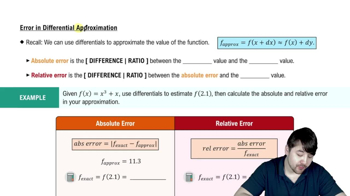Table of contents
- 0. Functions7h 52m
- Introduction to Functions16m
- Piecewise Functions10m
- Properties of Functions9m
- Common Functions1h 8m
- Transformations5m
- Combining Functions27m
- Exponent rules32m
- Exponential Functions28m
- Logarithmic Functions24m
- Properties of Logarithms34m
- Exponential & Logarithmic Equations35m
- Introduction to Trigonometric Functions38m
- Graphs of Trigonometric Functions44m
- Trigonometric Identities47m
- Inverse Trigonometric Functions48m
- 1. Limits and Continuity2h 2m
- 2. Intro to Derivatives1h 33m
- 3. Techniques of Differentiation3h 18m
- 4. Applications of Derivatives2h 38m
- 5. Graphical Applications of Derivatives6h 2m
- 6. Derivatives of Inverse, Exponential, & Logarithmic Functions2h 37m
- 7. Antiderivatives & Indefinite Integrals1h 26m
- 8. Definite Integrals4h 44m
- 9. Graphical Applications of Integrals2h 27m
- 10. Physics Applications of Integrals 2h 22m
4. Applications of Derivatives
Differentials
Problem 4.6.68
Textbook Question
Differentials Consider the following functions and express the relationship between a small change in x and the corresponding change in y in the form dy = f'(x)dx.
f(x) = sin⁻¹ x
 Verified step by step guidance
Verified step by step guidance1
First, understand that the problem is asking for the differential dy in terms of dx for the function f(x) = sin⁻¹(x). The differential dy represents the change in y corresponding to a small change in x, denoted as dx.
To find dy, we need to determine the derivative of the function f(x) = sin⁻¹(x) with respect to x. The derivative of sin⁻¹(x) is given by f'(x) = \( \frac{1}{\sqrt{1-x^2}} \).
Now, express the differential dy in terms of dx using the formula dy = f'(x)dx. Substitute the derivative we found into this formula.
This gives us dy = \( \frac{1}{\sqrt{1-x^2}} \) dx. This equation shows how a small change in x (dx) affects the change in y (dy) for the function f(x) = sin⁻¹(x).
Finally, remember that this relationship is valid for values of x within the domain of the inverse sine function, which is -1 ≤ x ≤ 1. This ensures that the expression under the square root is non-negative.
 Verified video answer for a similar problem:
Verified video answer for a similar problem:This video solution was recommended by our tutors as helpful for the problem above
Video duration:
2mPlay a video:
Was this helpful?
Key Concepts
Here are the essential concepts you must grasp in order to answer the question correctly.
Differentials
Differentials represent the infinitesimal changes in variables. In calculus, if y is a function of x, the differential dy is defined as the product of the derivative f'(x) and the differential dx, which represents a small change in x. This relationship helps in approximating how a small change in x affects the change in y.
Recommended video:

Finding Differentials
Derivative
The derivative of a function at a point measures the rate at which the function's value changes as its input changes. It is denoted as f'(x) and is calculated as the limit of the average rate of change of the function as the interval approaches zero. In the context of differentials, the derivative provides the necessary slope to relate changes in x and y.
Recommended video:

Derivatives
Inverse Function
An inverse function reverses the effect of the original function. For example, the inverse of f(x) = sin(x) is f⁻¹(x) = sin⁻¹(x), which takes a value from the range of the sine function and returns the corresponding angle. Understanding inverse functions is crucial when dealing with their derivatives, as the derivative of an inverse function can be found using the formula f⁻¹'(y) = 1 / f'(x) where y = f(x).
Recommended video:

Inverse Cosine






